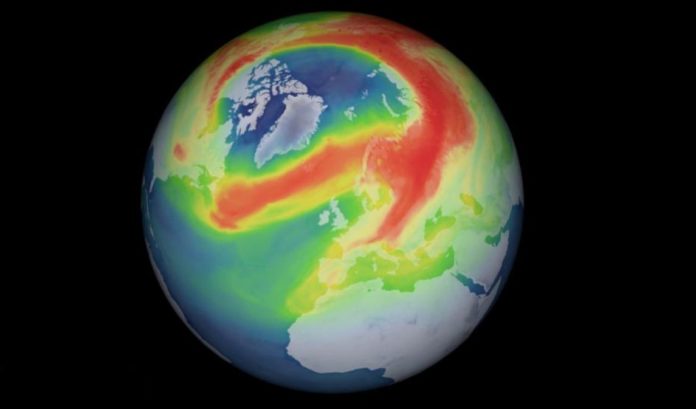The ozone layer is our natural shield and protects us from the harmful ultraviolet radiation from the Sun that can cause skin cancer, cataracts and also environmental problems.
We have known for decades that at the South pole (Antarctica) there is a hole in this protective layer. The latest data, very hopeful, offered a reduction of this hole. But, just now, at the other end of the Earth, another opens.
Now, the European Space Agency (ESA) has confirmed its existence using data from the Copernicus Sentinel-5P satellite.
Scientists at the German Aerospace Center (DLR) noted the especially sharp drop in ozone levels over the northern polar regions. Thanks to the data from the Tropomi instrument of the Copernicus Sentinel-5P satellite, it has been possible to monitor the formation of this Arctic ozone hole in the atmosphere.
The first theory that would explain its formation passes through unusual atmospheric conditions. According to scientists, unusually freezing temperatures in the stratosphere have caused levels to plummet and a “mini-hole” to open up in the ozone layer.
This hole is not the first time it has appeared, nor is it a consequence of human-made CFC gases. In the past, ‘mini-holes’ had already been detected over the north pole, but this time it is much larger and is lasting much longer than on other occasions.
It has a maximum extension of less than a million square kilometers. It is small if we think that the Antarctic hole can reach between 20 and 25 million square kilometers, with a normal duration of between three and four months
“The ozone hole we have observed over the Arctic this year has a maximum extent of less than a million square kilometers. It is small if we think that the Antarctic hole can reach between 20 and 25 million square kilometers, with a normal duration of between three and four months, “explains Diego Loyola, a scientist at the German Aerospace Center.
Extreme temperatures, causing the hole
During the winter months, when temperatures are usually extremely cold, both poles experience ozone depletion. For an ozone hole to form, temperatures below −80 ° C, sunlight, wind fields, and substances such as chlorofluorocarbons (CFCs) must be reached.
Normally the decline in the Arctic tends to be less than in Antarctica because temperatures do not reach such extreme levels. However, this year strong winds around the north pole trapped cold air in what is known as a “polar vortex”: a cyclone of stratospheric winds. According to ESA, in the late polar winter, with the first rays of sunlight over the north pole, this unusual drop in ozone began and the hole formed. Even so, its size is small compared to that usually observed in the southern hemisphere.
We expect the hole to close again by mid-April 2020
“Since March 14, the ozone columns over the Arctic have been reduced to what is normally considered ‘ozone hole levels’, less than 220 Dobson units. We expect the hole to close again by mid-April 2020, “explains Loyola.
Signs of recovery
Data from the 2018 Scientific Assessment of Ozone Depletion show that, in part of the stratosphere, the ozone layer has been recovering at a rate of 1-3% per decade since 2000. At these speeds, ozone from the northern hemisphere and mid-latitudes could recover around the year 2030; that of the southern hemisphere, around 2050, and that of the polar regions, around 2060.
The Tropomi instrument on the Copernicus Sentinel-5P satellite measures a number of trace gases, including aerosols, and the properties of clouds with global coverage and daily frequency. Given the importance of monitoring air quality and global ozone distribution, Copernicus’ upcoming Sentinel-4 and Sentinel-5 missions will monitor key trace gases for air quality, stratospheric ozone and aerosols.
“Tropomi’s total ozone measurements are expanding Europe’s ability to monitor global ozone, which has been doing tirelessly since 1995. During this time, we had failed to detect the formation of an ozone hole of this size over the Arctic,” explains Claus Zehner, head of Copernicus’ Sentinel-5P mission for ESA.
As part of the EU’s Copernicus program, the missions will offer information on air quality, solar radiation and climate monitoring.
